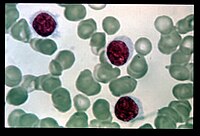
Photo from wikipedia
The presence of measurable residual disease (MRD) is the strongest predictor of relapse in acute lymphoblastic leukemia (ALL). We conducted a prospective, single‐arm, phase II study in adults with B‐cell… Click to show full abstract
The presence of measurable residual disease (MRD) is the strongest predictor of relapse in acute lymphoblastic leukemia (ALL). We conducted a prospective, single‐arm, phase II study in adults with B‐cell ALL with MRD ≥1 × 10−4 after ≥3 months from the start of frontline therapy or one month from any salvage therapy. Blinatumomab was administered at a standard dosing of 28 micrograms daily as a continuous infusion for up to five cycles and up to four additional maintenance cycles. Thirty‐seven patients with a median age of 43 years (range, 22–84 years) were treated. Twenty‐seven patients (73%) were treated in first complete remission (CR) and 10 patients (27%) in second CR and beyond. Eighteen patients (49%) had Philadelphia‐chromosome positive ALL and received concomitant tyrosine kinase inhibitor therapy. Twenty‐three patients (62%) had a baseline MRD ≥10−3. A median of three cycles (range, 1–9 cycles) were administered. Overall, 27 patients (73%) achieved MRD‐negative remission. With a median follow‐up of 31 months (range, 5–70 months), the estimated 3‐year relapse‐free survival (RFS) rate was 63% (95% confidence interval [CI], 43%–77%) and overall survival (OS) rate 67% (95% CI, 46%–81%). These rates were 51% (95% CI, 27%–70%) and 61% (95% CI, 36%–78%) in patients with baseline MRD ≥1 × 10−3, and 83% (95% CI, 45%–95%) and 77% (95% CI, 32%–95%) in patients with baseline MRD <10−3 respectively. The rates of adverse events were consistent with previous studies of blinatumomab. In summary, blinatumomab induced MRD negativity in most patients and resulted in high rates of RFS and OS. This study is registered at www.clinicaltrials.gov as #NCT02458014. Funding was provided by Amgen Inc.
Journal Title: American Journal of Hematology
Year Published: 2022
Link to full text (if available)
Share on Social Media: Sign Up to like & get
recommendations!